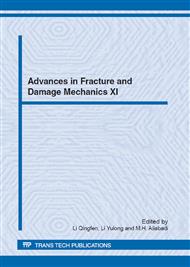[1]
Thevenot F. Boron carbide – a comprehensive review. J Eur Ceram Soc 1990; 6: 205-25.
Google Scholar
[2]
Jianxin D. Erosion wear of boron carbide ceramic nozzles by abrasive air jets. Mater Sci Eng A 2005; A408: 227-33.
DOI: 10.1016/j.msea.2005.07.029
Google Scholar
[3]
Yanfeng C, Yip-Wah C, Shuyou L. Boron carbide and boron carbonitride thin films as protective coatings in ultra-high density hard disk drives. Surf Coat Technol 2006; 200: 4072-7.
DOI: 10.1016/j.surfcoat.2005.02.164
Google Scholar
[4]
Dunner, Heuvel HJ, Horle M. Absorber materials for control rod systems of fast breeder reactors. J Nucl Mater 1984; 124: 185-94.
DOI: 10.1016/0022-3115(84)90022-9
Google Scholar
[5]
Jianxin D, Jun Z, Yihua F, Zeliang D. Microstructure and mechanical properties of hot-pressed B4C/(W, Ti)C ceramic composites. Ceram Int 2002; 28: 425-30.
DOI: 10.1016/s0272-8842(01)00113-4
Google Scholar
[6]
A. K. Suri, C. Subramanian, J. K. Sonber and T. S. R. Ch. Murthy. Synthesis and consolidation of boron carbide: a review. International Materials Reviews. 2010, 5, (1), 4-40.
DOI: 10.1179/095066009x12506721665211
Google Scholar
[7]
H. Lee and R. F. Speyer. Pressureless sintering of boron carbide.J. Am. Ceram. Soc., 2003, 86, (9), 1468–1473.
Google Scholar
[8]
R. F. Speyer and J. Lee. Advances in pressureless densification of boron carbide. J. Mater. Sci. , 2004, 39, 6017–6021.
DOI: 10.1023/b:jmsc.0000041698.23052.b9
Google Scholar
[9]
Y. Kanno, K. Kawase, K. Nakano, Additive effect on sintering of boron carbide, Yogyo-Kyokai-Shi 95 (11) (1987) 1137–1140.
DOI: 10.2109/jcersj1950.95.1107_1137
Google Scholar
[10]
T.K. Roy, C. Subramanian, A.K. Suri, Pressureless sintering of boron carbide, Ceram. Int. 32 (2006) 227–233.
DOI: 10.1016/j.ceramint.2005.02.008
Google Scholar
[11]
A. Goldstein, Y. Geffen, A. Goldenberg, Boron carbide–zirconium boride in situ composites by the reactive pressureless sintering of boron carbide zirconia mixtures, J. Am. Ceram. Soc. 84 (3) (2001) 642–644.
DOI: 10.1111/j.1151-2916.2001.tb00714.x
Google Scholar
[12]
Levin L, Frange N, Dariel MP. A novel approach for the preparation of B4C-basedcermets. Int J Refract Met Hard Mater 2000; 18: 131–135.
Google Scholar
[13]
Changming Xu, Yanbing Cai , KatarinaFlodstrom , ZheshenLi , Saeid Esmaeilzadeh, Guo-Jun Zhang. Spark plasma sintering of B4C ceramics: The effects of milling medium and TiB2 addition. 2004; 24: 2303-11. Int. Journal of Refractory Metals and Hard Materials . 2012, 30: 139–144.
DOI: 10.1016/j.ijrmhm.2011.07.016
Google Scholar


